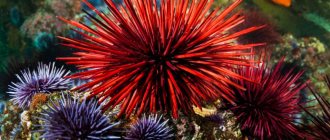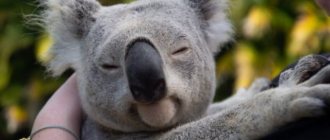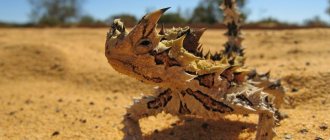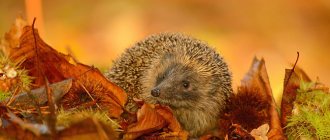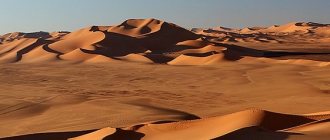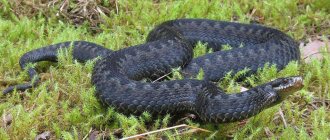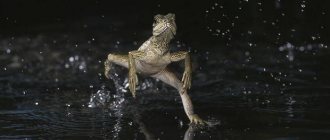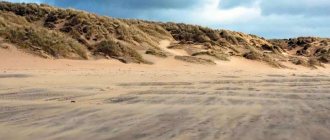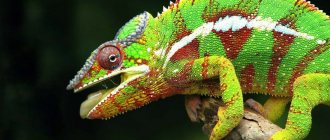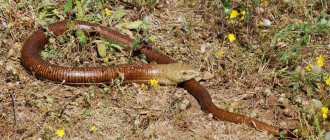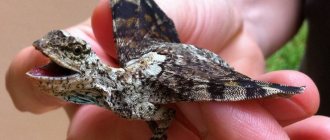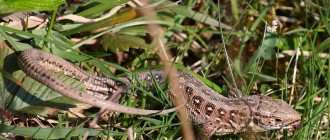Horned (or spiny) devil... this is what the Moloch lizard, which belongs to the agama family, is called in Australia.
Its first description, made in 1841, belongs to researcher John Gray. The animal received its name in honor of a deity named Moloch, one of the characters in pagan mythology. Why did the reptile come to be called the horned devil? Let's take a closer look at this creature, maybe it's his appearance?
Moloch lizard (Moloch horridus).
Description
Thanks to the large spines covering the entire body of the animal, the moloch is an easily recognizable lizard. With the exception of two large spines on the head, the rest of the spines are boneless. The entire body of the moloch is covered with thick scutes and spiny cones, and is also dotted with golden and brown spots, which serve as excellent camouflage in arid habitats. On the thorny dragon's head there are two horn-like spikes, and at the base of the neck the spikes form a cushion-like growth. Even the ventral surface is covered with small conical formations. For a long time it was assumed that the spiky armor of the moloch was a purely defensive function, protecting the lizards from predators. However, the complex surface structure of the thorny devil's skin also helps the animal accumulate, store and direct water to the corners of its mouth. The color of the moloch's skin changes depending on the ambient temperature; in the morning it is brownish or olive, and as the temperature rises in the afternoon it becomes light yellow. Observations suggest that they use postural changes to regulate the physiological state of the body.
Females are usually larger than males. The body weight of females ranges from 33 to 89 g (average 46 g), and body length without tail is from 8 to 11 cm (average 9 cm). The weight of males varies from 31 to 49 g, and the body length is 7.8-9.6 cm. The body weight of a moloch during the year can either increase or decrease by up to 30%. Oviposition in females leads to a significant loss of mass, which can quickly recover in a short period (up to 40% in 1-2 months). Males and females hatch from eggs with approximately equal body sizes, and grow at the same rate until one year of age. Then, females begin to grow faster, and at 5 years of age, growth stops.
What does Moloch look like?
At first glance, this animal looks menacing.
The body, the length of which in an adult can reach 20 cm, is quite dense and wide. The head of the moloch is small in size, the muzzle is blunt. The entire body, strewn with short, curved horny spines, is supported by short but strong legs.
The toes have claws.
Moloch's coloration is an excellent camouflage for the Australian deserts.
Above the eyes there are large, frightening-looking growths; the same ones are found on the limbs of the lizard, only in a smaller form.
The back is painted yellow-brown, which is diluted with dark spots. Dark patterned stripes adorn the belly, which has an ocher color.
The spiny devil is a fearsome-looking lizard.
Reproduction
Little information is known about the mating system of the Moloch lizard. Limited observations indicate that males approach females they believe are receptive to mating and bump heads. If the female is not receptive, she lies down and curls up to throw off the male.
The breeding season for thorny devils occurs at the end of winter (August-December). Females lay eggs in burrows up to 15 cm long and up to 22 cm deep. These burrows differ from the usual moloch shelters and are often located on the southern side of sandy ridges. Females lay from 3 to 10 (on average) eggs, which are incubated for 90-132 (on average 118) days. After laying the eggs, the females fall asleep and smooth the surface of the burrow to hide the clutch from predators. Newborn molochs weigh about 1.8 g. Before hatching, the young eat the shell of their egg.
Females lay eggs in burrows up to 15 cm long and up to 22 cm deep. These burrows differ from the usual moloch shelters and are often located on the southern side of sandy ridges. Females lay from 3 to 10 (on average) eggs, which are incubated for 90-132 (on average 118) days. After laying the eggs, the females fall asleep and smooth the surface of the burrow to hide the clutch from predators. Newborn molochs weigh about 1.8 g. Before hatching, the young eat the shell of their egg.
Brown bear
Having seen a bear in the circus, most people consider this giant to be docile and kind. The reality is very different from this idea. The bear is a large predator. Its weight reaches 800 kg, males grow up to two and a half meters in length. In the wild, bears are vegetarians. However, after a long, hungry winter, brown bears attack large and small animals.
The greatest aggression towards humans is shown by females guarding cubs and cubs that have not hibernated. Protecting the offspring, in search of food in winter, the bear is able to mistake people for easy prey.
Nutrition
Thorny dragons are myrmecophagous - animals that feed exclusively on ants. Their diet mainly consists of ants of the genera Iridomyrmex (especially Iridiomyrmex rufoniger) and Crematogaster. Also, sometimes the menu is supplemented with ants from the genera Ectatomma, Monomorium, Camponotus, Pheidole and Polyrhachis. Moloch sits in ambush and waits for the ants to pass nearby. For feeding, they choose areas near herbaceous and shrubby plants. Active nutrition begins at temperatures above 24 degrees Celsius. In some areas, moloch feeds in the morning (before 11 a.m.) or in the afternoon (from 3 to 6 p.m.). Since ants have relatively low nutritional value due to their high chitin content, lizards need to eat a lot of ants. The thorny dragon's large belly is well adapted to eating large quantities of food, and it is estimated that they eat about 750 ants per day. The average feeding rate of a moloch is 2.9 ants per minute, but instances of consuming 1 ant per second have been recorded. Research shows that lizards absorb about 59% of the metabolizable energy of their prey. Their fecal pellets are oval, black and shiny, and crumble easily due to their ant-like exoskeletons.
Moloch uses its complex skin structure to direct water to its mouth by capillary force. The base of the spine is surrounded by deep channels that effectively collect water, and then the water, as if through capillaries, even against gravity, is directed to the corners of the animal's mouth. These lizards live in extremely dry areas and the condensation of water on the surface of the body is a consequence of adaptation to difficult environmental conditions.
Accumulation
Usually, the inhabitants of deserts and semi-deserts have a secret for accumulating or economically using water. Moloch also has this. The lizard can store moisture due to the hygroscopicity of its skin: numerous spines significantly increase its surface. The entire area of the skin of a 22-centimeter reptile absorbs water.
And it increases significantly in size, by about 30 percent. Scientists were able to find out and understand how Moloch then spends this moisture only with the help of modern instruments. Under the keratinized scutes there are microscopic channels through which water moves into the mouth of the miracle lizard as needed. With the onset of the driest periods, the moloch takes refuge in the sand and hibernates.
Behavior
The thorny dragon can remain active over a wide range of body temperatures. The average body temperature of this lizard is 28.3 degrees Celsius. The greatest activity occurs in the fall (from March to May) and the end of winter (from August to December). They become almost completely inactive during the heat of summer (January-February) and the coldest months (June-July).
The Moloch lizard is not a territorial animal and does not have assigned territories. The habitat ranges of individual individuals overlap widely. The average distance that thorny dragons travel in one day is 77.9 m, but some individuals move more than 500 m. On average, males move more than females.
Pairing
In spring, which in the southern hemisphere begins in September, males begin searching for a sexually mature female. Since reptiles do not form pairs, after fertilization the female independently finds a suitable burrow, where she lays up to 10 eggs. It will camouflage the masonry and bury it almost all day long. It will take about 100-130 days before the small and absolutely helpless “horned devils” hatch. Really, what kind of devils are there if their length is half a centimeter and their weight is 2 grams? At first they will feed on the shells of the eggs from which they hatched, then they will begin to climb to the surface. Molochs grow slowly, until they reach sexual maturity and the required 22 centimeters of height, it will take 5 years.
Such prolonged maturation is not good for lizards. Australian zoologists are forced to fence off the clutches, which gives little Molochs the opportunity to leave them alive and healthy. For now, this work allows us to preserve the only representative of this interesting species.
Predators
Although the thorny devil is covered with sharp spines and is well camouflaged in its environment, these lizards sometimes become prey for the Australian bustard, humans, black buzzard and monitor lizard. When the moloch feels threatened, it sticks its head between its front paws, which prevents the predator from stroking it.
Notes
- BioLib Profil taxonu - druh ďábel medvědovitý Sarcophilus harrisii
Boitard, 1841 (Czech) - Sokolov V. E.
Five-language dictionary of animal names. Mammals. Latin, Russian, English, German, French. / under the general editorship of academician. V. E. Sokolova. - M.: Rus. lang., 1984. - P. 16. - 10,000 copies. - Wroe, S.; McHenry, C.; Thomason, J. (2005). "Bite club: comparative bite force in large biting mammals and the prediction of predatory behavior in fossil taxa." Proceedings of the Royal Society B-Biological Sciences 272
(1563): 619–625. DOI:10.1098/rspb.2004.2986. PMID 15817436. - ↑ 1 2
Guiler, E. R. (1970).
“Observations on the Tasmanian devil, Sarcophilus harrisii
II.
Reproduction, Breeding and Growth of Pouch Young." Australian Journal of Zoology 18
: 63–70. DOI:10.1071/ZO9700063. - Tasmanian marsupial devil (Sarcophilus harrisii). Encyclopedia of the animal world "AnimalBox". Retrieved January 18, 2015.
- Tasmanian Devil Cancer Culprit Revealed | Wired Science | Wired.com
- Tasmanian devils have been found to have a genetic predisposition to some individuals being resistant to DFTD
- There's a glimmer of hope for Tasmanian devils
- Bad news for the devils
- Lenta.ru: The strategy to save Tasmanian devils was considered unsuccessful
- The updated Linux kernel received a new logo
- Reilly, Pauline;
Rolland, Will. The Tasmanian devil. - Kenthurst, New South Wales: Kangaroo Press, 1988. - ISBN 0-86417-207-9. - Owen, Pemberton, 2005, pp. 145–165.
- Williams, Jasper;
Suzuki, John; De Zoete, Claire. Tasmanian devils. - South Yarra, Victoria: Macmillan Education Australia, 2007. - ISBN 978-1-4202-1924-1. - Currey, Kylie;
Parrish, Steve. Growing up as a devil. - Archerfield, Queensland: Steve Parish Publishing, 2006. - ISBN 1-74021-794-2. - Erven, A. et al. (2002). "A novel stereocilia defect in sensory hair cells of the deaf mouse mutant Tasmanian Devil." European Journal of Neuroscience 16
: 1433-1441. DOI:10.1046/j.1460-9568.2002.02213.x. PMID 12405956.
Role in the ecosystem
The main role of molochs in the ecosystem is to control the ant population of the regions where they live. They coexist with other insectivorous lizards, however, the thorny dragon's diet is more generalized than that of other species.
Molochs, as a rule, are largely parasitized by nematodes. These worms may use ants or termites as intermediate hosts to reach their final hosts, lizards.
Interesting feature
They are so slow and harmless that nature gave them a second head as protection from enemies. It is well known that any lizard can escape if an enemy grabs it by the tail. She will easily part with him, and the tail will then grow back. But this is not our moloch (lizard). A false head is what he will give without hesitation to the predator who attacks him. Having tilted the real one lower, the moloch exposes the horn-like growths on the neck to the enemy’s teeth, which save him. By the way, this may also be why it was once believed that Molochs were scary animals. You might really think so, because his head was bitten off, but he remained alive. So what to do? You have to be smart, otherwise you won’t live 20 years when there are monitor lizards, snakes, birds all around - and they are all faster, stronger and larger.
Economic significance for humans: positive and negative
Thorny dragons are very popular in zoos due to their specific appearance. They are also used for scientific research and educational purposes.
There is no confirmed data on the adverse economic effects of moloch on humans.
Flora and fauna of the Gibson Desert
In addition to the fact that Homo sapiens managed to take root here, some animals, although not numerous, also live in the desert. Among them the most interesting are:
- Moloch lizard;
- ostrich Emu;
- marsupial badger;
- striped grass wren;
- red kangaroo;
- avdotka.
Unfortunately, the badgers mentioned above (also known as great bilbies) are facing complete extinction, although this animal once inhabited two-thirds of the continent. The reason for this is poaching, coupled with the poor reproduction of the badgers themselves.
The fur of these animals is very beautiful, which could not escape the attention of fashionistas greedy for jewelry, which created a great demand, to which poachers readily responded.
- The Gibson Desert is home to perhaps the most fearsome lizard on the planet, the moloch. Although its size is, at best, 25 cm to the tip of its tail, it deserves its name because it has a more than terrifying appearance.
- In appearance, she looks like a small monitor lizard, whose entire body is covered with eerie-looking thorns. At the same time, the moloch can change its color, making it lighter or darker. But this is not enough: the Moloch lizard is capable of inflating itself with air, significantly increasing in size.
- The main food of the lizard is ants, which it eats with incredible speed. The lack of moisture faced by the desert-dwelling moloch is compensated by folds of skin that trap not only raindrops, but also dew.
- Another iconic inhabitant of the desert reserve is the red kangaroo, which is known as the largest marsupial species. In accordance with its size, it has very strong and long hind limbs, thanks to which it can (if desired, naturally) reach speeds of up to 70 km/h.
- In addition to terrestrial fauna, the desert is also home to a fairly large number of birds. They do not nest here permanently, preferring to visit the salt marsh lakes of the Gibson Desert after rainfall.
- To preserve the limited fauna of the Gibson Desert, a reserve of the same name was established here in 1977.
As for the flora of the Gibson Desert, it is also not very diverse. The most common are spinifex, veinless acacia and quinoa, which look very picturesque against the backdrop of local landscapes.
Sea Horse
Photo: FASTILY / Wikimedia Commons
The shape of the seahorse resembles a “horse” chess piece, which is why the fish got its name. In the Black Sea there are several species of seahorses, whose sizes range from 2 to 30 cm. The shape of the skates does not allow them to move quickly in the water, but they do not need it. With the help of their tail, they attach to plants, after which they change color, merging with them. This allows you to protect yourself from predators.
At the same time, seahorses themselves are predators. They feed on shrimp and crustaceans. Skates simply use their pipette-like mouth to suck in water when prey swims near them.
Seahorses are distant relatives of pipefish and therefore reproduce in a similar way. The female lays eggs in the male's body. This fish is considered a special delicacy, although many species are listed in the Red Book. In some high-end restaurants, a seahorse dish costs $800.
Lighting for spiketail
Spiny lizards require adequate exposure to ultraviolet B light, provided by a fluorescent lamp or mercury vapor lamp. Buy bulbs with a UVB output of at least 8 to 10 percent (higher UVB output is also excellent and preferred). And keep this bulb on a 12-hour cycle to simulate sunrise and sunset.
Place the flashlight at a distance of 25-30 cm from the place where the lizard itself is sunbathing. Since mesh screens block much of the UVB rays, install them under the screen if possible. Any reflectors inside a fluorescent fixture also help maximize the lamp's efficiency.
Replace fluorescent lamps every six months or as recommended by the manufacturer. Even if the lamp still produces light, invisible UVB rays stop being emitted after six months.
Birds
Birds found in the desert include eagles, vultures, Mediterranean falcons, African ostriches, desert larks, sandgrouses, golden avoc-billed woodpeckers and many others.
Compared to most other desert inhabitants, birds have great advantages. Unlike mammals with a constant body temperature, the body temperature of birds is much higher, so they tolerate heat more easily. But even more important is that they can fly, which makes it possible, in extreme heat, to rise higher into cooler layers of air.
Birds of prey circle in a column of rising air high above the desert, where it is much cooler than at the surface of the earth. But most often in the midday heat, birds sit motionless under bushes or among tree branches. They shift their activity to more pleasant morning hours.
